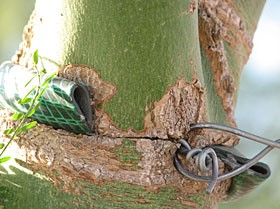A newly-planted young tree is staked to stabilize it until the roots extend through the soil sufficiently to support it without assistance. Even slight uprooting, if not discovered promptly, can lead to damage or death of the tree.
Trees that may need staking include those with roots inadequate to support above-ground mass, which is the case for bare root trees or those with small root balls. Tall, top-heavy trees and slender, delicate trunks may also need some help.
Qualities of the site or soil may also dictate the need for additional support. These sights include windy areas, extreme rainfall and locations with alot of human or animal traffic.
Soil texture plays a lot in anchoring the roots properly. Sandy loam, loose organic material and forest fines are some examples of that. In this case, more stabilization and soil amendments may be required for proper rooting to occur. The rooting process usually takes about 1 year.

As we see in the first photo, someone was very determined to immobilize this tree!
Complete immobility is not a reasonable or desired result.
* If wind or other factors cause strong movement, the one-sided mooring can
cause the young tree to snap.
* The fasteners will rub against the tree bark, eliminating the tree’s protection
wherever there is friction and expose the tree to moisture and illness. If a tree has
too much of it’s protective bark removed, it is likely that the tree will die from the
exposure. This is referred to as “girdling.”
 Correct tree staking employs two or more stakes opposite each other, and ideally parallel to the direction of the prevailing wind whenever possible.
Correct tree staking employs two or more stakes opposite each other, and ideally parallel to the direction of the prevailing wind whenever possible.
* Proper tree staking/strapping materials are flexible, non-abrasive and adjustable and
should not be tied too tightly but have a little “give”.
* The tree is allowed some movement of trunk and branches, while keeping it’s
feet firmly planted. This kind of movement stimulates root growth as well as
Increasing the growth of the trunk diameter, leading to a much more healthy
outcome for the tree.
Usually, depending on the size of the tree when it was planted, the strapping or staking materials can be removed at the beginning of the next growth cycle. If staking is to remain in place, the strapping and adjustments must be checked to make sure the tension is correct and the bark of the tree free of restrictions.

